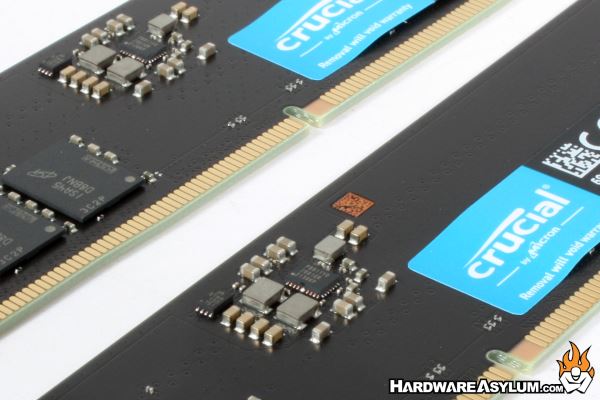Crucial Memory 4800Mhz DDR5 Memory Review
Author: Dennis GarciaIntroduction
When Alder Lake launched in 2021 it brought with it a variety of new technologies and concepts. The processor itself was a hybrid design which divided parts of the CPU into efficiency and performance cores. That not only increased performance but delivered a solid solution for power management when the system isn’t crunching numbers.
Alder Lake also changed the concept of the HEDT by delivering workstation class performance without needing elaborate quad channel memory controllers and massive amounts of PCI Express lanes. Instead, the platform introduced PCI Express 5.0 which can deliver 5x the bandwidth of the original PCI Express implementation and DDR5.

In this review we will be looking at a DDR5 memory kit from Crucial. Currently these modules come in only a single speed at 4800Mhz and a total of three module densities from 8GB, 16GB and 32GB. As you would expect the modules can be purchased as a single UDIMM or in dual module/channel kits giving you plenty of options when it comes to configurating your system builds.
As was mentioned before Alder Lake brings with it a new DDR memory standard designed to handle the memory demands of modern systems and the new processor architecture. It offers the promise of higher memory speeds at the expense of higher latencies. This is not uncommon given that while the technology changes they still conform to the same basic rules and it often takes some time before we see latencies drop and speeds increase.
For instance, when DDR3 and DDR4 launched many enthusiasts noted that the memory timings had more than double from the previous generation and often ran at the same speed, if not slower. This translated into lower than expected memory performance and with every new processor release came improved memory utilization and better overall performance.
Fortunately, DDR5 and the Alder Lake platform has already proven it can be faster than the previous generation however, many applications are not optimized to take advantage of the memory bandwidth and even if it is a major performance bottleneck and it is difficult to know if memory speed is a contributing factor or is simply being masked off by an overtly massively powerful CPU.
Despite these “growing pains” DDR5 brings with it many benefits such as a higher default speed of 4800Mhz and lower operating voltages of 1.1v. The DDR5 architecture also supports higher chip densities allowing manufacturers to create much larger memory modules with fewer chips. This increases performance across the board and lowers manufacturing costs at the same time.

